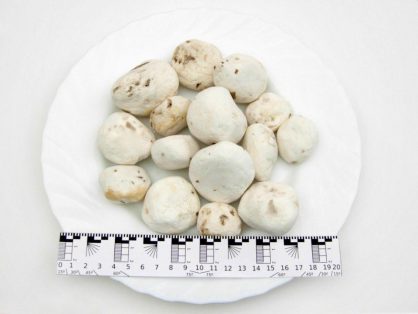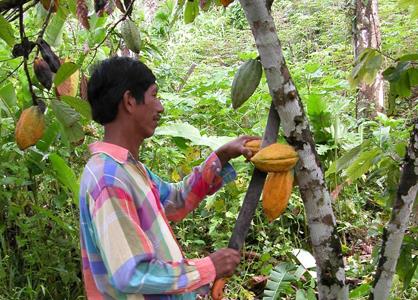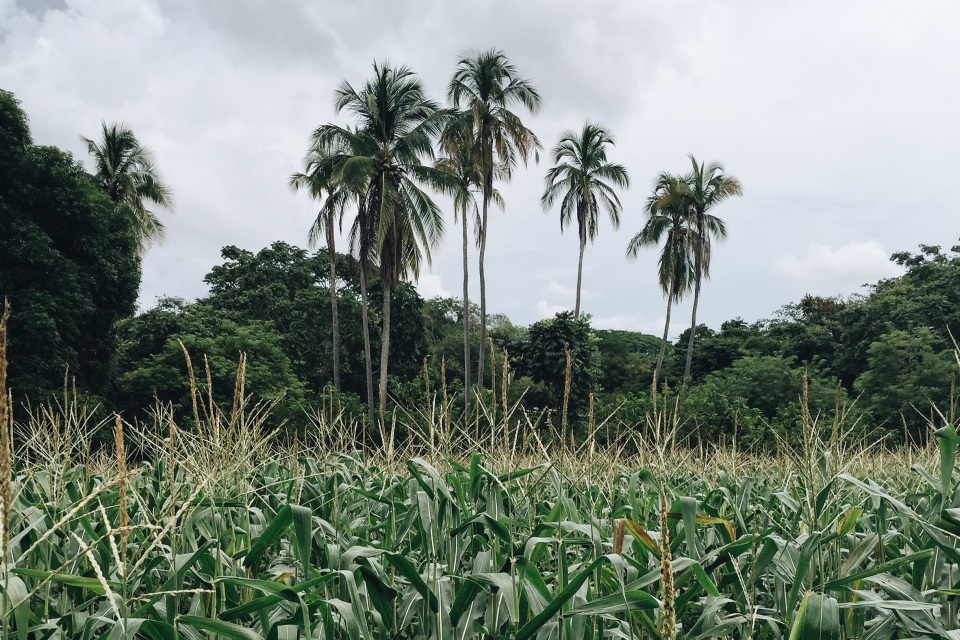Cooperatives – The Anwser to increase Resilience?
By Delphine Scheerens (Belgium) and Diana Arguello (Ecuador)
Dieser Artikel wurde im Rahmen von LACalytics veröffentlicht, einem Projekt der Organisation Young Initiative on Foreign Affairs and International Relations (IFAIR e.V.), welches junge ExpertInnen aus Latein Amerika, der Karibik und der EU zusammenbringen soll. In internationalen Teams verfassen sie Artikel zu den Themenschwerpunkten Wirtschaft, Politik, Umwelt, Zivilgesellschaft sowie EU - Latein Amerika Beziehungen. Als Publikationspartner veröffentlicht facing-change.org eine Reihe ausgewählter umweltrelevanter Artikel.
Vulnerability of small-scale farmers in Peru and Ecuador in a scenario of climate change
A large percentage of poor people in Peru and Ecuador lives in rural areas and depends directly on natural resources.[i] In the present scenario of climate change this implies that small-scale farmers are a particularly vulnerable group. Ecuador has evidenced some changes in climate patterns.[ii] In the province of Azuay, for example, the San Bartolomé parish has experienced episodes of extreme drought in 2009. Since 2012 this has been resulting in low production of various crops, deterioration of pastures for livestock, shorter water distribution and the consequent economic losses for the farmers. On the other hand, winter rains cause excessive erosion which worsen the soil quality.[iii] In Cusco, Peru, the rise in temperature has been gradual in the high areas (3500 meters above sea level), while in the lower regions (2000 meters) near Machu Picchu, there has been a slight cooling over the past 40 years.[iv] These kinds of climate change effects complicate small farmers‘ abilities to effectively perform agricultural activities, affecting directly their incomes and their lands. Hence, climate change makes them more vulnerable.
The socio-economic situation of Peruvian and Ecuadorian farmers limits their adaptive capacity to these climatic changes.[v],[vi] Poverty rates in Ecuador reached 57,8% in rural and 24.8% in urban areas in 2014.[vii] Peru showed slightly better data, with 46 % and 15,3%, respectively.[viii] Still, this clearly demonstrates that vulnerability and poverty prevails among rural populations which consist of mainly farmers.
The limited capacity of rural farmers to cope with climate change is also due to the lack of knowledge of adaptation measures.[ix] Yet, improved farming techniques, adapted to local realities, such as agro-forestry systems, integrated pest and water management, erosion control, increased genetic diversity for climate resilience, restoration of degraded lands and recovery of ancestral knowledge, among others, could play an important role in minimizing the negative effects of climate change.[x],[xi]
In this scenario, the cooperative model arises as an alternative to promote local activities which could improve the resilience of agricultural communities and at the same time promote capacity building and constitute an economic model that will allow farmers to further market their goods. At the same time, it allows them to gain independence from government or NGO support.
The potential of the cooperative model in increasing resilience among small-scale farmers in Peru and Ecuador
Two main problems hinder small-scale farmers in Peru and Ecuador to enhance their resilience. First of all, they lack financial resources to affront crop failures, for example, and to implement innovative farming techniques which tend to require substantial investments. Second, they face a shortage of sufficient knowledge about adaptation measures.
The cooperative business model can contribute to overcome these problems by improving individual farmers’ incomes, providing knowledge about adaptation measures and technical assistance to implement these. Coopagros, a cooperative of potato producers from Peru, and KALLARI, a cooperative of cacao and chocolate producers from Ecuador, show how this can work in practice.[xii]
Coopagros from the Apurímac region in Peru was founded as an association in 2002 and transformed into a cooperative in 2013. It currently has 266 members who all cultivate native potato species. KALLARI cooperative was established in 2003 and is formed by 850 members from 21 communities, mostly indigenous, located in the Biosphere Reserve of Sumaco, in the Napo Province, in the Ecuadorian Amazon. KALLARI promotes the organic cultivation of cocoa and its transformation into chocolate.
The cooperative model in the agricultural sector takes shape as a group of farmers who jointly own a democratically-controlled enterprise in order to meet their common economic, social, and cultural needs.[xv] [xvi] The members of a cooperative have a direct say in how their cooperative develops, the products and services the cooperative provides, and prices that are charged. Also, they are guided in their actions by values such as self-help, self-responsibility, democracy, equality, transparency and solidarity. The cooperative model in Peru and Ecuador has its roots in the indigenous community tradition of cooperating. Until today rural populations are organized in communities, but throughout the years ancestral traditions and knowledge about, for example, natural resource management techniques have experienced a progressive loss. This knowledge degradation started off during colonization and has been affected by other factors like poverty and marginalization.[xiii] As a consequence, to enforce their rights and seek further development, communities tend to adopt a complementary form of organization with a legal status, such as a cooperative.[xiv]
Farmers organized in cooperatives have better incomes
Research has shown that producers organized through cooperatives have better incomes, more savings and spend less on purchasing supplies than non-cooperative members.[xvii] Coopagros offers its members joint purchases of supplies and joint commercialization of potatoes. KALLARI is in charge of managing, industrializing and jointly commercializing the production. For both cooperatives, these services and better bargaining capacity through the cooperative have led to a reduction of middlemen in the value chain raising the income of their individual members and thus increasing their resilience.
Additionally, both cooperatives promote added value to the products of its members. Usually the cooperative assumes the risk by investing in the necessary machinery. Coopagros is currently promoting the reintroduction of the tunta, a small frozen and dehydrated potato, in order to add value to the small potatoes that traditionally are not commercialized. The cooperative invests in a freezer for common use and is already looking for potential markets. KALLARI, in its turn, has supported its members to transform cacao into chocolate, which has considerably increased their incomes.

Source: © Jaroslaw Filiochowski (jarfil). A plate with tunta.
Nevertheless, in order to increase or maintain the income of each member, cooperatives face several challenges, such as finding new markets or suffering from a lack of productive capacity. This leads to difficulties in delivering large orders and keeping up with quality norms demanded by the markets.
Cooperatives as knowledge providers
Further, cooperatives promote improving knowledge on adaptation measures and building capacities to implement such strategies amongst its members as one of their basic principles.[xviii] Coopagros organizes training sessions for its members teaching them the use of organic fertilizers and promotes and assists in the implementation of sustainable practices, such as reforestation at the borders of potato fields and at the origins of water basins.
Similarly, the KALLARI cooperative contributed to avoid logging activities that put a constant threat to their area by promoting a more sustainable and economically richer way of using the forest: the production of chocolate. Also, the members now use organic fertilizers and agro-forestry techniques that are efficient to protect the ecosystem and thus increase their resilience.[xix] [xx] They also promote the inclusion of traditional knowledge, which has proven to be effective in climate change adaptation efforts[xxi], [xxii]such as the “Chakra”[xxiii] technique.

Source: ©Kallari. Cacao pods in the Ecuadorian rainforest.KALLARI.com[xxiv]
Another way of increasing resilience is through diversification in cultivation and the recovery of more resilient crop varieties. Coopagros fosters the cultivation of more resilient varieties of native potatoes and of alternative crops, such as tarwi[xxv], a native Andean lupin with high protein content. KALLARI also has diversified its products, as they now sell a variety of fruits, handicrafts and medicinal herbs, besides their main products, cacao and chocolate.
Both cases from Peru and Ecuador show that the cooperative model can play an important role in increasing resilience among farmers, particularly by improving the economic situation of the individual farmers through joint commercialization and added value, and by providing knowledge about innovative and ancestral adaptation techniques and more resilient crop varieties.
Challenges for the cooperative model
Cooperatives in Peru and Ecuador often receive financial and technical support from the government or NGOs for their general functioning or for specific projects that, amongst others, support climate change adaptation efforts. This initial financial and technical support is often necessary to help cooperatives get started and acquire the required skills to manage their operations. Yet, it should be temporary, and a strong capacity building plan is required so that sustainability and independence can be ensured in the future.
Currently, Coopagros receives financial and technical support from one NGO and from the municipality of Kishuara. However, it foresees to be 100% self-sustainable by 2019 thanks to a higher sales volume, added value to small potatoes, product diversification, higher member contributions, and the intensification of their microcredits service.
KALLARI received technical assistance and funds from about 40 different institutions and volunteers that contributed to create the cooperative. After this initial phase, however, they became financially independent. Thus, they now manage to produce and commercialize their chocolate locally and internationally which proved to be an important step to help them become economically sustainable.
Even so, capital remains a constant necessity and maintaining the profitability is a challenge. Besides being capable of adapting to climate changes, farmers must also be prepared for fast changes in commodity prices.[xxvi] KALLARI’s revenue growth depends on variations in the price of chocolate.[xxvii] Therefore, the introduced product diversification is crucial for long-term financial independence.
The cooperative model is a competitive alternative for small farmers in Peru and Ecuador to achieve sustainable production, but it faces several challenges in its implementation. Other models like associations or watershed management committees are common forms of organization among rural communities; however, they may not be necessarily focused on the complete value chain of products, as cooperatives tend to do.
Recommendations for policy makers
Considering the benefits for small-scale farmers cooperatives provide, this model should be included, through a participatory process with farmer communities, in the National Climate Change Plans of Peru[xxviii] and Ecuador[xxix]. Additionally, public policies directed at climate change adaptation should work with cooperatives as an instrument to foster sustainable practices and increase resilience of small-scale farmer communities.
Further, as evidenced before, the most difficult step for small farmers to increase their resilience is to improve their financial situation, through better access to the market and the elimination of middlemen. The cooperative model can contribute to overcome this obstacle through joint commercialization, for example, but governments could also play a role, as they could boost direct sales of cooperatives’ products. In Brazil, for example, public schools have to spend at least 30% of the available financial resources for school meals on the purchase of products from local family agriculture by law.[xxx] [xxxi] [xxxii] Alongside this initiative, negotiating processes could be developed to achieve responsible and fair agreements so that cooperatives can become suppliers of private sector corporations, without interventions of middlemen.
Also, in order to overcome the limited access farmers have to knowledge about adaptation techniques, governmental education programs to promote capacity building, recovery of ancestral knowledge and agricultural extension services[xxxiii] to farmers and their organizations, such as cooperatives, should be intensified.
In sum, both cases have shown that cooperatives are able to sustainably improve the livelihoods of farmers and provide the necessary knowledge about adaptation techniques to their members, increasing their resilience. Nevertheless, their often fragile financial situation, due to volatile commodity prices and difficulties to access markets or provide large orders, and their dependency on governmental or NGO support, challenges the economic sustainability. An intensification of governmental support for this business model is therefore an important step to contribute to the optimization of its potential in local adaptation strategies.

